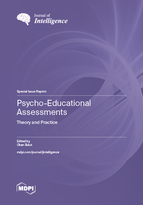Psycho-Educational Assessments: Theory and Practice
A special issue of Journal of Intelligence (ISSN 2079-3200).
Deadline for manuscript submissions: closed (15 October 2022) | Viewed by 55432
Special Issue Editor
Interests: psychometrics; psycho-educational assessments; educational data mining; big data modeling; large-scale testing; learning analytics; digital assessments; computerized adaptive testing; statistical programming
Special Issues, Collections and Topics in MDPI journals
Special Issue Information
Dear Colleagues,
Psycho-educational assessments (e.g., intelligence tests, cognitive test batteries, and behavioral measures) are important instruments that help both school psychologists and educators to better understand children’s learning and behavioral profiles. Using psycho-educational assessments, school psychologists and educators can identify each student’s strengths and weaknesses in terms of academic and cognitive abilities. Furthermore, these assessments can be used for identifying children with learning disabilities, intellectual differences, and social–emotional challenges as well as gifted and talented children. The results of psycho-educational assessments are useful not only for diagnosing possible learning or developmental problems but also for planning timely interventions and support programs to accommodate the specific needs of students.
The focus of this Special Issue is psycho-educational assessments designed for the population of school-aged children (i.e., children aged 5 to 19). We encourage submissions that present findings of empirical research or theoretical work related to the design, use, analysis, interpretation, and reporting processes of psycho-educational assessments. The topics that this Special Issue is soliciting submissions on include, but are not limited to:
- Innovative assessment methods and models;
- Individual and group psycho-educational assessments;
- Validity studies of new or existing psycho-educational assessments;
- The diagnostic accuracy of psycho-educational assessments;
- Psycho-educational assessments and report writing;
- Data science methods for analyzing the results of psycho-educational assessments.
Prof. Okan Bulut
Guest Editor
Manuscript Submission Information
Manuscripts should be submitted online at www.mdpi.com by registering and logging in to this website. Once you are registered, click here to go to the submission form. Manuscripts can be submitted until the deadline. All submissions that pass pre-check are peer-reviewed. Accepted papers will be published continuously in the journal (as soon as accepted) and will be listed together on the special issue website. Research articles, review articles as well as short communications are invited. For planned papers, a title and short abstract (about 100 words) can be sent to the Editorial Office for announcement on this website.
Submitted manuscripts should not have been published previously, nor be under consideration for publication elsewhere (except conference proceedings papers). All manuscripts are thoroughly refereed through a double-blind peer-review process. A guide for authors and other relevant information for submission of manuscripts is available on the Instructions for Authors page. Journal of Intelligence is an international peer-reviewed open access monthly journal published by MDPI.
Please visit the Instructions for Authors page before submitting a manuscript. The Article Processing Charge (APC) for publication in this open access journal is 2600 CHF (Swiss Francs). Submitted papers should be well formatted and use good English. Authors may use MDPI's English editing service prior to publication or during author revisions.
Keywords
- intelligence
- cognitive ability
- psychometric testing
- diagnostic assessment
- learning disability
- social–emotional problems







